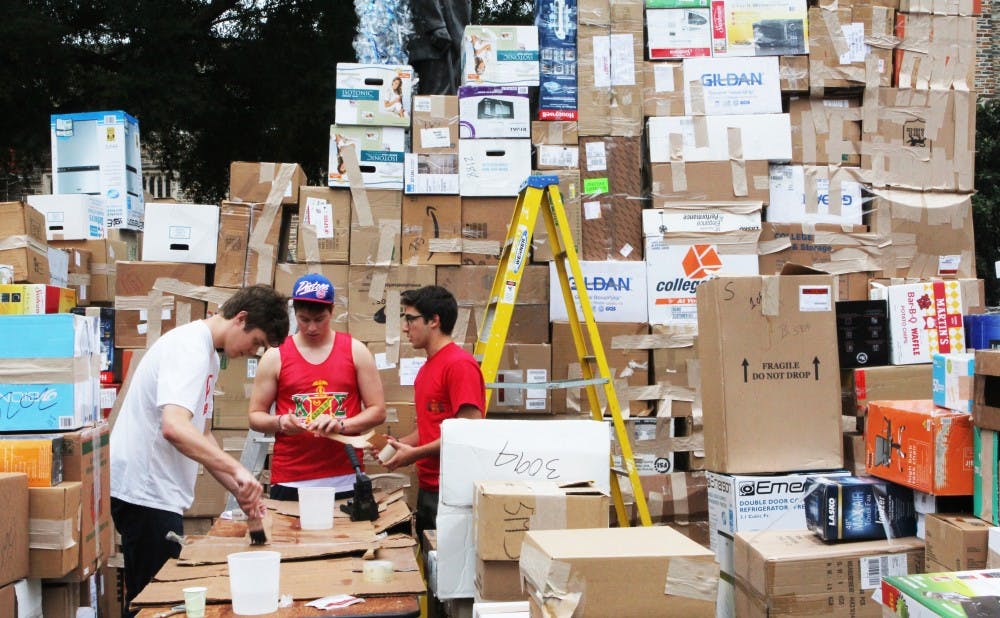Cardboard boxes and volunteers littered the Chapel Quad as students beat the world record for the largest structure constructed with only boxes and tape.
Fort Duke—made from more than 3,500 cardboard boxes—was the result of collaboration between Duke Sanitation and Recycling Services, Sustainable Duke and the Duke Arts Festival. Two-thirds of boxes used were taken from move-in days on East and West Campus.
The goal of Fort Duke was twofold, said Arwen Buchholz, Duke's recycling and waste reduction coordinator.
“Number one, break the world record and number two, have students see and conceptualize [our waste],” Buchholz said.
The fort's structure was designed by Todd Berreth, an architect and IT analyst and research programmer for the University. He proposed two designs—one a labyrinth and tower and the other a Grecian influence. The departments involved chose the labyrinth and tower, because it required less ladders, cranes, and tools.
The construction process was not without obstacles, however—most notably the weather.
“Nature kicked in with some rain, which was the most troublesome thing that happened,” said Bill Fick, visiting assistant professor of the practice of visual arts. “We [also] had to make some adjustments to the design because we were going to be more ambitious with the tower. We were going to go 24.5 feet, but we ended up at about half that height.”
The collaboration between departments and students showed how art can impact other areas, Fick said.
“Duke has always been known as a research university for the sciences and medicine, but I think the role of art is happening,” Fick said. “There’s a lot of interest in how the arts can be included in other academic programs and this was a great example of that.”
More than 200 students signed in to help build Fort Duke, but even more dropped by to help, Buchholz said.
“After realizing how huge the fort was, I was like, ‘Wow, we waste a lot.’ All of these cardboard boxes, we have to do something with them,” said sophomore Sofia Calicchio, a civil engineering major. “And then there were a lot of stickers inside that said sustainability, so it really got me thinking.”
The fort was not the only piece of environmentally friendly art on the quad—there was also an installation of water bottles cut and assembled into a cape for the James B. Duke statue, created by local artist Bryant Holsenbeck.
“My work is about ‘away,’” Holsenbeck said. “We throw stuff ‘away’ but ‘away’ is a place that we’re responsible for.”
The collaboration between artists and students was a positive sign of the event's success in raising awareness about sustainability, said Beverly Meek, arts outreach and communications assistant for the Office of the Vice Provost for the Arts.
“This really came from a group of people that came around an idea and a belief in recycling and doing something more than what we see,” Meek said. “If we keep doing this, we can really make a difference in the environment and how we approach it ourselves.”
The tie between the environment and the arts will also be showcased at this year's Duke Arts Festival, held in the Bryan Center from October 25 to November 3, which will exhibit student pieces showing how arts can raise awareness about sustainability. Holsenbeck’s work, titled “Falling Water: Plastic Sea,” will also be on display.
“One of the challenges with the arts festival is coming up with things that people can’t miss,” Vice Provost for the Arts Scott Lindroth said. “A fort isn’t necessarily an artistic masterpiece, but it engages many students. We can use this as a way to introduce the festival and bring [sustainability] to people’s minds so they can get involved.”
Get The Chronicle straight to your inbox
Signup for our weekly newsletter. Cancel at any time.

